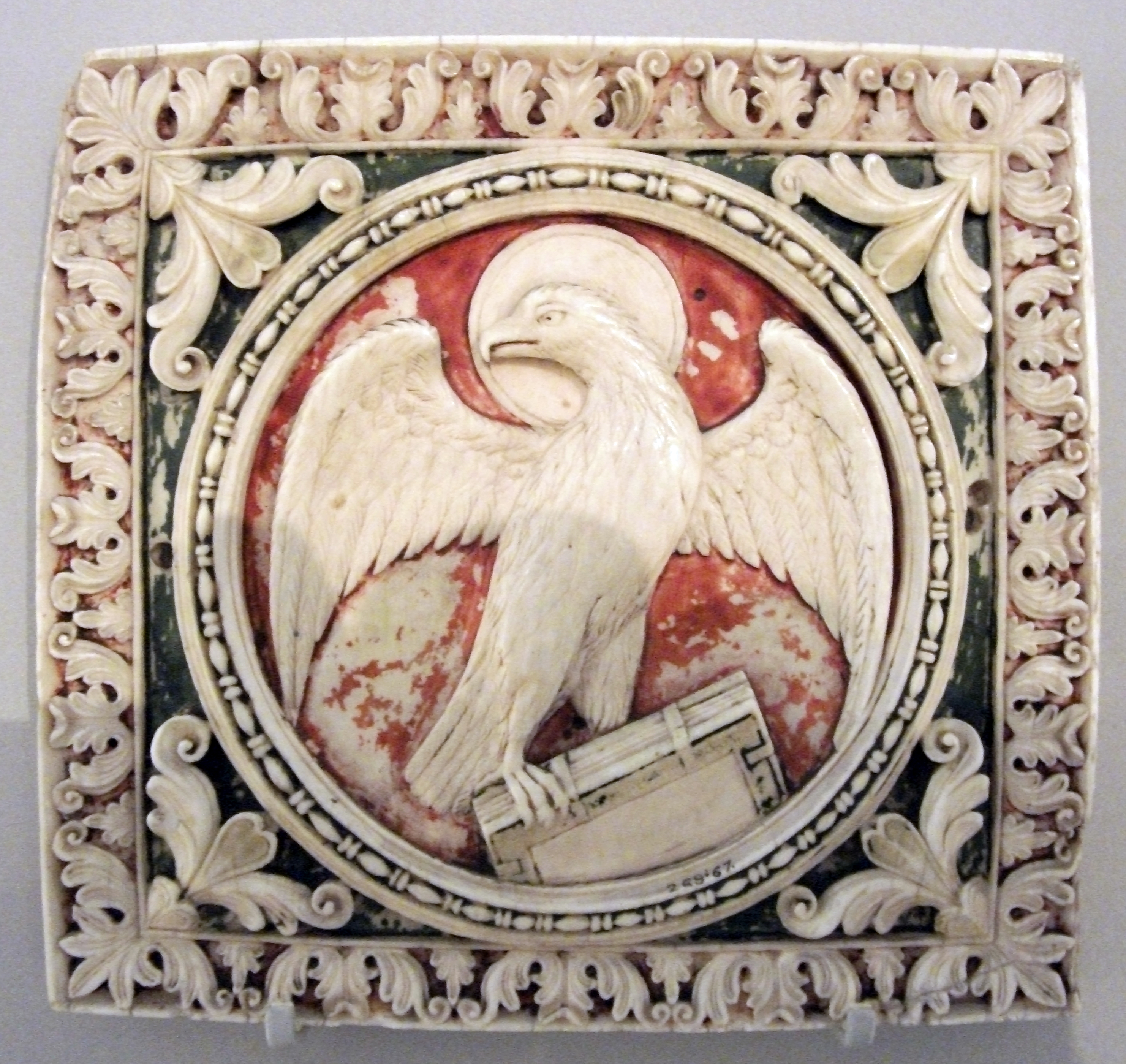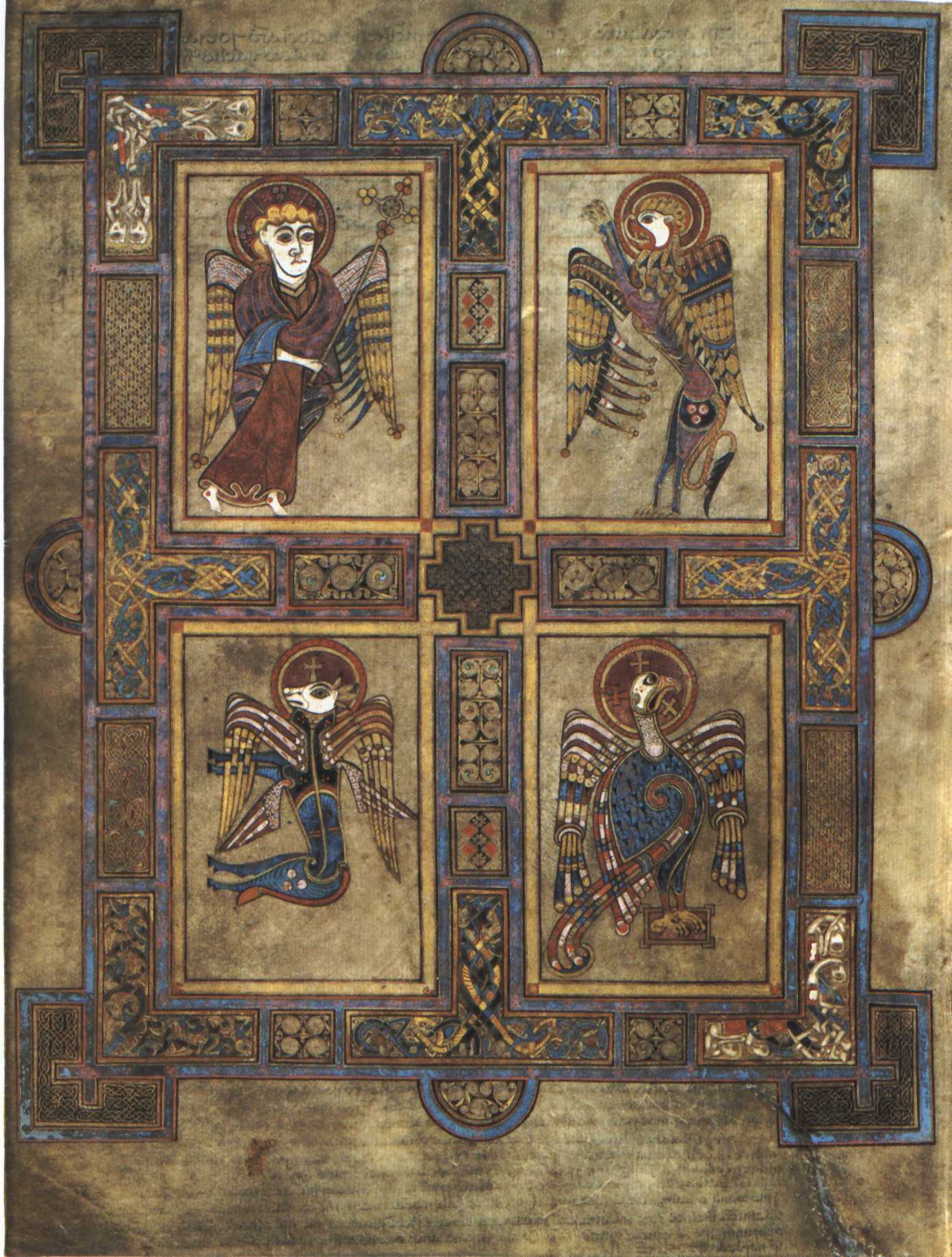|
Tetramorph
A tetramorph is a symbolic arrangement of four differing elements, or the combination of four disparate elements in one unit. The term is derived from the Greek ''tetra'', meaning four, and ''morph'', shape. The word comes from the Greek for "four forms" or "shapes". In English usage, each symbol may be described as a tetramorph in the singular, and a group as "the tetramorphs", but usually only in contexts where all four are included. The tetramorphs were especially common in Early Medieval art, above all in illuminated Gospel books, but remain common in religious art to the present day. In Christian art, the tetramorph is the union of the symbols of the Four Evangelists, derived from the four living creatures in the Book of Ezekiel, into a single figure or, more commonly, a group of four figures. Each of the four Evangelists is associated with one of the living creatures, usually shown with wings. The most common association, but not the original or only, is: Mark the King, Li ... [...More Info...] [...Related Items...] OR: [Wikipedia] [Google] [Baidu] |
Eagle Of Saint John
The Eagle of Saint John () is a heraldic eagle associated mostly with the Catholic Monarchs which was later used during Francoist Spain (1938–1977) and the Spanish transition to democracy (1977–1981). It is sable with an or halo and feet of gules. Symbol of John the Evangelist John the Evangelist, the author of the fourth gospel account, is symbolized by an eagle, often with a halo, an animal may have originally been seen as the king of the birds. The eagle is a figure of the sky, and believed by Christian scholars to be able to look straight into the sun. It appears with other three beings as the tetramorph, interpreted in Christianity as symbols of the evangelists. The four beings appear as the living creatures in the Bible. Use by Isabella I of Castile The better known heraldic use of the Eagle of St. John has been the single supporter chose by Queen Isabella of Castile in her armorial achievement used as heiress and later integrated into the heraldry of the Catholic ... [...More Info...] [...Related Items...] OR: [Wikipedia] [Google] [Baidu] |
Living Creatures (Bible)
The living creatures, living beings, or ''chayyoth'' () are a class of heavenly beings in Judaism. They are described in the prophet Ezekiel's vision of the heavenly chariot in the first and tenth chapters of the Book of Ezekiel. References to the sacred creatures recur in texts of Second Temple Judaism, in rabbinical ''merkabah'' ("chariot") literature, in the Book of Revelation in the Christian New Testament, and in the Zohar. According to Judaism, Jewish and Christianity, Christian traditions, there are four living creatures, although their description varies by source. The symbolic depiction of the four living creatures in religious art, especially Christian art, is called a tetramorph. Ezekiel's four living creatures Ezekiel's vision of the four living creatures in Ezekiel 1 are identified as cherubim in Ezekiel 10, who are God's throne bearers. Cherubim as minor Tutelary deity, guardian deities of temple or palace thresholds are known throughout the Ancient East. In Ezek ... [...More Info...] [...Related Items...] OR: [Wikipedia] [Google] [Baidu] |
Christ In Majesty
Christ in Majesty or Christ in Glory () is the Western Christian image of Christ seated on a throne as ruler of the world, always seen frontally in the centre of the composition, and often flanked by other sacred figures, whose membership changes over time and according to the context. The image develops from Early Christian art, as a depiction of the Heavenly throne as described in 1 Enoch, Daniel 7, and The Apocalypse of John. In the Byzantine world, the image developed slightly differently into the half-length Christ Pantocrator, "Christ, Ruler of All", a usually unaccompanied figure, and the Deesis, where a full-length enthroned Christ is entreated by Mary and St. John the Baptist, and often other figures. In the West, the evolving composition remains very consistent within each period until the Renaissance, and then remains important until the end of the Baroque, in which the image is ordinarily transported to the sky. Development From the latter part of the fourth cen ... [...More Info...] [...Related Items...] OR: [Wikipedia] [Google] [Baidu] |
Ezekiel
Ezekiel, also spelled Ezechiel (; ; ), was an Israelite priest. The Book of Ezekiel, relating his visions and acts, is named after him. The Abrahamic religions acknowledge Ezekiel as a prophet. According to the narrative, Ezekiel prophesied the destruction of Judah's capital city Jerusalem. In 587 BC, the Neo-Babylonian Empire conquered Jerusalem, destroyed Solomon's Temple, and sent the Judahite upper classes into the Babylonian captivity. However, Ezekiel also prophesied the eventual restoration of the Jewish people to the Land of Israel. It is believed he died around 570 BC; Ezekiel's Tomb is a Jewish religious site in Mesopotamia. Three decades later, in 539 BC, the Persian empire conquered Babylon and the Edict of Cyrus repatriated the exiles. The name "Ezekiel" means "God is strong" or "God strengthens" in Hebrew. Biblical account The author of the Book of Ezekiel presents himself as Ezekiel, the son of Buzi, born into a priestly ( kohen) lineage. The aut ... [...More Info...] [...Related Items...] OR: [Wikipedia] [Google] [Baidu] |
Assyria
Assyria (Neo-Assyrian cuneiform: , ''māt Aššur'') was a major ancient Mesopotamian civilization that existed as a city-state from the 21st century BC to the 14th century BC and eventually expanded into an empire from the 14th century BC to the 7th century BC. Spanning from the early Bronze Age to the late Iron Age, modern historians typically divide ancient Assyrian history into the Early Assyrian period, Early Assyrian ( 2600–2025 BC), Old Assyrian period, Old Assyrian ( 2025–1364 BC), Middle Assyrian Empire, Middle Assyrian ( 1363–912 BC), Neo-Assyrian Empire, Neo-Assyrian (911–609 BC), and Post-imperial Assyria, post-imperial (609 BC– AD 240) periods, based on political events and gradual changes in language. Assur, the first Assyrian capital, was founded 2600 BC, but there is no evidence that the city was independent until the collapse of the Third Dynasty of Ur, in the 21st century BC, when a line of independent kings starting with Puzur-Ashur I began rulin ... [...More Info...] [...Related Items...] OR: [Wikipedia] [Google] [Baidu] |
Sphinx
A sphinx ( ; , ; or sphinges ) is a mythical creature with the head of a human, the body of a lion, and the wings of an eagle. In Culture of Greece, Greek tradition, the sphinx is a treacherous and merciless being with the head of a woman, the haunches of a lion, and the wings of a bird. According to Greek myth, she challenges those who encounter her to answer a riddle, and kills and eats them when they fail to solve the riddle. This deadly version of a sphinx appears in the myth and drama of Oedipus. In Egyptian mythology, in contrast, the sphinx is typically depicted as a man (an androsphinx ()), and is seen as a benevolent representation of strength and ferocity, usually of a pharaoh. Unlike Greek or Levantine/Mesopotamian ones, Egyptian sphinxes were not winged. Both the Greek and Egyptian sphinxes were thought of as guardians, and statues of them often flank the entrances to temples. During the Renaissance, the sphinx enjoyed a major revival in European decorative art. D ... [...More Info...] [...Related Items...] OR: [Wikipedia] [Google] [Baidu] |
Babylon
Babylon ( ) was an ancient city located on the lower Euphrates river in southern Mesopotamia, within modern-day Hillah, Iraq, about south of modern-day Baghdad. Babylon functioned as the main cultural and political centre of the Akkadian-speaking region of Babylonia. Its rulers established two important empires in antiquity, the 19th–16th century BC Old Babylonian Empire, and the 7th–6th century BC Neo-Babylonian Empire. Babylon was also used as a regional capital of other empires, such as the Achaemenid Empire. Babylon was one of the most important urban centres of the ancient Near East, until its decline during the Hellenistic period. Nearby ancient sites are Kish, Borsippa, Dilbat, and Kutha. The earliest known mention of Babylon as a small town appears on a clay tablet from the reign of Shar-Kali-Sharri (2217–2193 BC), of the Akkadian Empire. Babylon was merely a religious and cultural centre at this point and neither an independent state nor a large city, s ... [...More Info...] [...Related Items...] OR: [Wikipedia] [Google] [Baidu] |
Harpy
In Greek and Roman mythology, a harpy (plural harpies, , ; ) is a half-human and half-bird mythical creature, often believed to be a personification of storm winds. They feature in Homeric poems. Descriptions Harpies were generally depicted as birds with the heads of maidens, faces pale with hunger and long claws on their hands. Roman and Byzantine writers detailed their ugliness. Pottery art depicting the harpies featured beautiful women with wings. Ovid described them as human- vultures. Hesiod To Hesiod, they were imagined as fair-locked and winged maidens, who flew as fast as the wind: Aeschylus Even as early as the time of Aeschylus, harpies were thought to be ugly creatures with wings, and later writers carried their notions of the harpies so far as to represent them as most disgusting monsters. The Pythian priestess of Apollo compares the appearance of the Erinyes, chthonic goddesses of vengeance, with those of harpies in the following lines of The Eumenides: ... [...More Info...] [...Related Items...] OR: [Wikipedia] [Google] [Baidu] |
Taurus (astrology)
Taurus (; , Latin for "bull") is the second astrological sign in the modern zodiac. It spans from 30° to 60° of the zodiac. This sign belongs to the Earth element or triplicity, as well as a fixed modality, quality, or quadruplicity. It is a Venus-ruled sign, the Moon is in its exaltation here at exactly 3°. The Sun transits this sign from approximately April 20 until May 20 in western astrology. Taurus is one of the three earth signs, alongside Capricorn and Virgo. Taurus's opposite sign is Scorpio. History The bestial sign of Taurus is associated with several myths and bull worship from several ancient cultures. It was the first sign of the zodiac established among the Mesopotamians, who called it "The Great Bull of Heaven", as it was the constellation through which the Sun rose on the vernal equinox at that time, that is the Early Bronze Age, from about 4000 BC to 1700 BC. The zodiac sign of Taurus does not entirely align with the constellation of Taurus. Taur ... [...More Info...] [...Related Items...] OR: [Wikipedia] [Google] [Baidu] |
Babylonian Exile
The Babylonian captivity or Babylonian exile was the period in Jewish history during which a large number of Judeans from the ancient Kingdom of Judah were forcibly relocated to Babylonia by the Neo-Babylonian Empire. The deportations occurred in multiple waves: After the siege of Jerusalem in 597 BCE, around 7,000 individuals were deported to Mesopotamia. Further deportations followed the destruction of Jerusalem and Solomon's Temple in 587 BCE. Although the dates, numbers of deportations, and numbers of deportees vary in the several biblical accounts, the following is a general outline of what occurred. After the Battle of Carchemish in 605 BCE, the Babylonian king Nebuchadnezzar II besieged Jerusalem, which resulted in tribute being paid by the Judean king Jehoiakim. In 602 BCE, Jehoiakim refused to pay further tribute, which led in 598/597 BCE to another siege of the city by Nebuchadnezzar II and culminated in the death of Jehoiakim and the exile to Babylonia of his ... [...More Info...] [...Related Items...] OR: [Wikipedia] [Google] [Baidu] |
Leo (astrology)
Leo (; , Latin for "lion") is the fifth Astrological sign, sign of the zodiac. It corresponds to the Leo (constellation), constellation Leo and comes after Cancer (astrology), Cancer and before Virgo (astrology), Virgo. The traditional Western zodiac associates Leo with the period between about July 23 and August 22, and the sign spans the 120th to 150th degree of celestial longitude. Leo is associated with Fire sign, fire, accompanied by Aries (astrology), Aries and Sagittarius (astrology), Sagittarius, and its modality is fixed sign, fixed. The constellation Leo is associated with the mythological Nemean lion. The lion is a very important and prominent symbol in Greek mythology. History Egyptians worshipped the constellation, which they referred to as "Knem", because it was present during the flooding of the Nile River. This event signified plentiful harvests for the upcoming year, and the people interpreted it as a gift from the earth. Ruler of Egypt, Tutankhamun, Tutankham ... [...More Info...] [...Related Items...] OR: [Wikipedia] [Google] [Baidu] |








